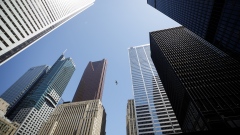Jun 28, 2024
Barclays Says Buy Inflation Protection to Prepare for Trump Win
, Bloomberg News

(Bloomberg) -- To interest-rate strategists at Barclays Plc watching the presidential debate Thursday night, the trade was clear: buy inflation hedges in the US Treasury market.
With former president Donald Trump appearing more likely to unseat Joe Biden in the Nov. 5 election, the market should “be pricing in a considerable risk of higher-than-target inflation in the coming years, and this is from a starting point of our thinking they already offered structural value,” Barclays strategists Michael Pond and Jonathan Hill said in a note.
The simple trade, they wrote, is a wager that five-year Treasury inflation-protected securities, or TIPS, will outperform regular five-year Treasuries, leading to a wider yield spread between the two. That breakeven rate — representing the market-implied expectation for the average inflation rate of the consumer price index over the life of the securities — will widen to 2.5% from about 2.25% currently, Barclays projects.
Trump has proposed steep tariffs on imports, particularly on goods from China, and an aggressive effort to deport those working in the US illegally. He has also pledged to extend across-the-board tax cuts, which would likely worsen the federal deficit and add stimulus to an economy that the Federal Reserve is seeking to restrain.
At 2.25%, the five-year breakeven rate suggests that the market’s expectation for CPI are in line with the Fed’s 2% target, the strategists said. The Fed targets a different inflation gauge — the price index for personal consumption expenditures — which averages 30 basis points to 40 basis points lower than the CPI.
Inflation continues to exceed the Fed’s target rate, but by shrinking margins. Data released Friday showed the PCE price index increased 2.6% in May from a year earlier, down from 2.7% in April. The core PCE price index, which excludes food and energy, also rose 2.6%, the slowest increase since March 2021.
But if the odds in the coming months continue to favor a second Trump term, “we would expect them to be embedded in the market via higher breakevens as the November elections approach,” Pond and Hill wrote.
©2024 Bloomberg L.P.







